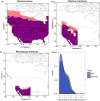Does metabolism constrain bird and mammal ranges and predict shifts in response to climate change?
- PMID: 30619552
- PMCID: PMC6308872
- DOI: 10.1002/ece3.4537
Does metabolism constrain bird and mammal ranges and predict shifts in response to climate change?
Abstract
Mechanistic approaches for predicting the ranges of endotherms are needed to forecast their responses to environmental change. We test whether physiological constraints on maximum metabolic rate and the factor by which endotherms can elevate their metabolism (metabolic expansibility) influence cold range limits for mammal and bird species. We examine metabolic expansibility at the cold range boundary (MECRB) and whether species' traits can predict variability in MECRB and then use MECRB as an initial approach to project range shifts for 210 mammal and 61 bird species. We find evidence for metabolic constraints: the distributions of metabolic expansibility at the cold range boundary peak at similar values for birds (2.7) and mammals (3.2). The right skewed distributions suggest some species have adapted to elevate or evade metabolic constraints. Mammals exhibit greater skew than birds, consistent with their diverse thermoregulatory adaptations and behaviors. Mammal and bird species that are small and occupy low trophic levels exhibit high levels of MECRB. Mammals with high MECRB tend to hibernate or use torpor. Predicted metabolic rates at the cold range boundaries represent large energetic expenditures (>50% of maximum metabolic rates). We project species to shift their cold range boundaries poleward by an average of 3.9° latitude by 2070 if metabolic constraints remain constant. Our analysis suggests that metabolic constraints provide a viable mechanism for initial projections of the cold range boundaries for endotherms. However, errors and approximations in estimating metabolic constraints (e.g., acclimation responses) and evasion of these constraints (e.g., torpor/hibernation, microclimate selection) highlight the need for more detailed, taxa-specific mechanistic models. Even coarse considerations of metabolism will likely lead to improved predictions over exclusively considering thermal tolerance for endotherms.
Keywords: distribution; endotherm; metabolic expansibility; metabolic scope; range limit; thermal neutral zone.
Figures




References
-
- BirdLife International and NatureServe (2014). Bird species distribution maps of the world. Cambridge, UK and NatureServe, Arlington, USA: BirdLife International.
-
- Boyles, J. G. , Thompson, A. B. , McKechnie, A. E. , Malan, E. , Humphries, M. M. , & Careau, V. (2013). A global heterothermic continuum in mammals. Global Ecology and Biogeography, 22, 1029–1039. 10.1111/geb.12077 - DOI
Associated data
LinkOut - more resources
Full Text Sources
Other Literature Sources

